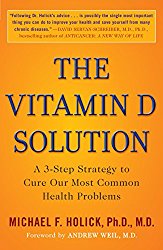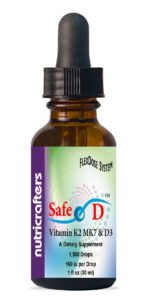 Michael F. Holick, M.D., PhD., the world’s leading expert on vitamin D says that the 200 million Americans who are deficient in this essential vitamin are suffering from chronic diseases and life-threatening illnesses, including heart disease, diabetes, depression, obesity and osteoporosis as a result. Holick, who has been studying vitamin D for more than 35 years, is author of the book, The Vitamin D Solutions: A 3-Step Strategy to Cure Our Most Common Health Problem (Penguin/Hudson Street Press; April 1, 2010), in which he identifies the causes of vitamin D deficiency and outlines why it is essential to our health.
Michael F. Holick, M.D., PhD., the world’s leading expert on vitamin D says that the 200 million Americans who are deficient in this essential vitamin are suffering from chronic diseases and life-threatening illnesses, including heart disease, diabetes, depression, obesity and osteoporosis as a result. Holick, who has been studying vitamin D for more than 35 years, is author of the book, The Vitamin D Solutions: A 3-Step Strategy to Cure Our Most Common Health Problem (Penguin/Hudson Street Press; April 1, 2010), in which he identifies the causes of vitamin D deficiency and outlines why it is essential to our health.
Order The Vitamin D Solution: A 3-Step Strategy to Cure Our Most Common Health Problems from Amazon
Vitamin D is actually a hormone that is made in the skin as a result of exposure to sunlight. The problem is, if you live at a latitude of 42 degrees (a line approximately between the northern border of California and Boston) the sun’s rays are too low between November and February for your skin to get the sunlight needed for cutaneous vitamin D synthesis.12
If you live at a latitude below 34 degrees north (a line between Los Angeles and Columbia, South Carolina) your body can make vitamin D from sun exposure yearlong. However, it’s important to expose a large portion of bare skin (like your midriff) to mid-day sun for at least 15 minutes every day. Most people are unable to fit this into their schedule, so vitamin D supplementation is highly recommended, especially since so few foods contain it. Salmon, tuna, sardines, milk, and fortified cereals provide more than 100 IUs per serving. And mushroom is the only food in the produce section that has vitamin D.
But consider how much of each of these foods you’d have to eat in order to get the RDA (recommended daily allowance) of 200 IUs for people up to 50 years of age, 400 IUs for people between 51 and 70, and 600 IUs for over 70s years. And according to a recent study published in the Journal of Nutrition (March 9, 2009) adults need at least four times the current recommended dose of vitamin D.3
Additionally, in 2008 The American Academy of Pediatrics recommended intakes of 400 IUs of vitamin D for children and adolescents, based on evidence from more recent clinical trials.4
Why is Vitamin D so important?
Through Holick’s research, we now know that every body cell has a receptor for vitamin D, which is why it is so crucial to overall health. Vitamin D is most commonly known for helping the digestive system absorb calcium and phosphorus. In that way it helps the body build and maintain healthy bones. But it does much more.
Adequate vitamin D is necessary for reducing the risk for bone disease. Vitamin D is believed to play a role in the reduction of falls, as well as reducing pain, autoimmune diseases, cancer, heart disease, mortality and supporting cognitive function.5
Vitamin D and the cardiovascular system
Surveys suggest that at least one-third of American adults, and 75% of adults with cardiovascular disease are deficient in vitamin D.6 Low vitamin D levels were reported as a risk factor for increased cardiovascular disease among 1739 adult participants in the Framingham Offspring Study.7
High blood pressure
Studies suggest that low vitamin D contributes to high blood pressure.8 An article that recently appear in the American Journal of Therapeutics discusses how ten observational studies and nine randomized control trials concerned with the association between vitamin D and blood pressure were analyzed. Of these, eight observational studies and three randomized control trials supported an inverse association between vitamin D and blood pressure. It concluded that current observational studies strongly support an inverse association between vitamin D and blood pressure, but this association has yet to be convincingly supported with randomized control trials.9
Helps patients with kidney disease
Although vitamin D deficiency is common in patients with chronic kidney disease, epidemiologic studies have suggested that patients with chronic kidney disease who are treated with vitamin D have a survival advantage when compared with those who do not receive treatment.10
Reduces risk of colorectal cancer
Colorectal cancer (CRC) is the second leading cause of cancer mortality in the United States. There is growing evidence that vitamin D may reduce the incidence of CRC. Results of epidemiologic, in vitro, in vivo animal and clinical studies suggest that a low serum vitamin D level may be a serious risk factor for CRC and a high serum vitamin D level may reduce the risk of CRC.11
The safest way to increase your intake of vitamin D is to take a vitamin D supplement providing 1000 IUs of cholecalciferol in each capsule year-round, and to take a daily noon walk —if the weather is fine.
References
- Holick MF. Vitamin D: the underappreciated D-lightful hormone that is important for skeletal and cellular health. Curr Opin Endocrinol Diabetes 2002;9:87-98.
- Holick MF. Vitamin D. In: Shils ME, Shike M, Ross AC, Caballero B, Cousins RJ, eds. Modern Nutrition in Health and Disease, 10th ed. Philadelphia: Lippincott Williams & Wilkins, 2006.
- Nelson, M.L. Blum, J.M, Hollis, B.W., Rosen, C., Sullivan, S.S.Supplements of 20 ug/d Cholecalciferol Optimized Serum 25-Hydroxyvitamin D Concentrations in 80% of Premenopausal Women in Winter. Journal of Nutrition, March 9, 2009, Volume 139, Pages 540-546, doi:10.3945/jn.108.096180
- Wagner CL, Greer FR; American Academy of Pediatrics Section on Breastfeeding; American Academy of Pediatrics Committee on Nutrition. Prevention of rickets and vitamin D deficiency in infants, children, and adolescents. Pediatrics. 2008 Nov;122(5):1142-52.
- Stechschulte SA, Kirsner RS, Federman DG. Vitamin D: bone and beyond, rationale and recommendations for supplementation. Am J Med. 2009 Sep;122(9):793-802.
- Harvard Health Publications, Harvard Medical School. “Vitamin D: a bright spot in nutrition research.”
- Wallis DE, Penckofer S, Sizemore GW. The “sunshine deficit” and cardiovascular disease. Circulation 2008; 118:1476-85.
- Artaza JN, Mehrotra R, Norris KC. Vitamin D and the cardiovascular system. Clin J Am Soc Nephrol. 2009 Sep;4(9):1515-22. Epub 2009 Aug 20.
- Lee JH, O’Keefe JH, Bell D, Hensrud DD, Holick MF. Vitamin D deficiency an important, common, and easily treatable cardiovascular risk factor? J Am Coll Cardiol. 2008 Dec 9;52(24):1949-56.
- Feneis JF, Arora RR. Role of Vitamin D in Blood Pressure Homeostasis. Am J Ther. 2010 Mar 5. [Epub ahead of print]
- Hansen D, Brandi L, Rasmussen K. [Vitamin D, cardiovascular disease and mortality in patients with kidney disease] [Article in Danish] Ugeskr Laeger. 2009 Dec 7;171(50):3684-9.
